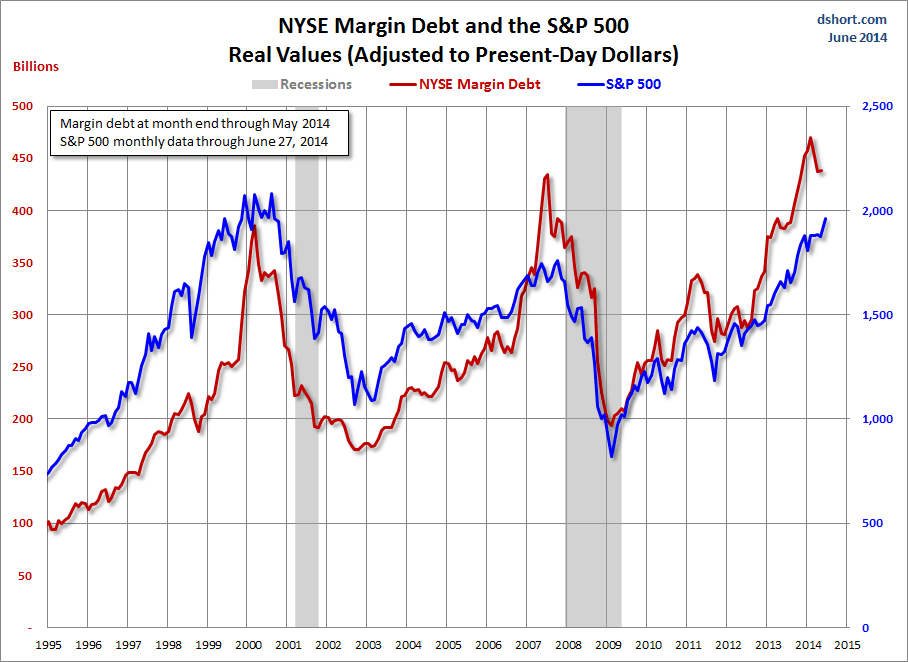Leading Indicator Says Stock Market Crash Imminent
June 26 2014
The current stock market boom is a result of a reckless zero interest rate policy. Driven by loose credit, the Dow Jones Index reached new record highs earlier this year. Margin debt — the total amount of credit which is used to buy securities ‘on margin’ at a stock brokerage — also made record highs. It’s not the first time that both — margin debt and stock
Leading Indicator Says Stock Market Crash Imminent
The current stock market boom is a result of a reckless zero interest rate policy. Driven by loose credit, the Dow Jones Index reached new record highs earlier this year. Margin debt — the total amount of credit which is used to buy securities ‘on margin’ at a stock brokerage — also made record highs.
It’s not the first time that both — margin debt and stock prices — move in concert. After margin debt made new highs in 2001 and 2008, a subsequent decline in margin debt preceded an ensuing recession and stock market crash. It was a leading indicator of the crashes in 2001 and 2008. Margin debt was pushed up during the dotcom and subprime mortgage bubble before coming crashing down some months in advance of a stock market crash.
Investors, take note. Margin debt has been declining over the past two months, which indicates a pending stock market correction. We might be in the endgame of a boom market that lasted from 2011 to 2014.

Source: dshort.com, NYSE
What Happened During Earlier Warning Signals?
The last time NYSE margin debt declined at this rate was in 2011. This decline preceded the stock market crash of August 2011. Stocks went down about 15%, but more surprising was the volatility during the decline. On Friday August 8, 2011, the Dow Jones lost 4.3% in a single day. Just one trading day later, on August 9, now called Black Monday, stocks tumbled even lower and declined an additional 5.6%, the 6th largest drop in history.
If we go further back, we see that earlier declines of margin debt include the ones in 2007 and 2000. These were clear warning signals of not only a severe decline in stock prices, but also of a recession. A few months after margin debt began to decline, stock markets crashed. No false signals have been given, besides perhaps in 2010, although a case can be made that a decline in margin debt preceded the infamous May 6, 2010 Flash Crash when the Dow Jones plunged around 1,000 points or 9%.
The Chicken or the Egg
Is it the abundant credit open to investors that drives stock prices? Or does margin debt merely reflect sentiment, as investors are willing to take greater risk and leverage up? It might be both: the availability of cheap credit in combination with positive investor sentiment is needed to push margin debt higher.
Lance Roberts of STA Wealth Management perhaps puts it best: “The current levels of margin debt are indicative of an extremely optimistic view of the market. What is important to remember is that margin debt "fuels" major market reversions as "margin calls" lead to increased selling pressure to meet required settlements. Unfortunately, since margin debt is a function of portfolio collateral, when the collateral is reduced it requires more forced selling to meet margin requirements. If the market declines further the problem becomes quickly exacerbated. This is one of the main reasons why the market reversions in 2001 and 2008 were so steep. The danger of high levels of margin debt, as we have currently, is that the right catalyst could ignite a selling panic.
The issue is not whether margin debt will matter, just "when." Unfortunately, for many unwitting investors, when that time comes margin debt will matter "a lot."”
The Parallels between Today and the Great Depression
We can observe some interesting similarities between the progression of the Great Depression in the 1930s and the stock market at that time and what is happening today.
The Great Depression also had plenty of talk about a ‘recovery’ and there were quarters and even years of nominal GDP growth. Yet nobody would call, in retrospect, the period between 1931 and 1934, when GDP grew, a recovery.
The stock market also boomed during that period, but it went on to crash again and lost almost 50% of its value after this brief period of alleged ‘recovery’.
How Will It Play Out?
How will this play out? We’ll have to wait and see. No indicator is perfect and even total margin debt might give us a wrong signal, bouncing back to new record highs after declining for the past months.
However, given a variety of other indicators we can say with confidence that a correction in stock prices is highly likely and something that will happen rather sooner than later.
I recall that the last time margin debt gave out a warning signal, stocks crashed and gold soared.